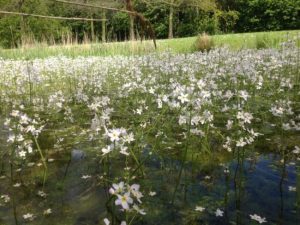Waterviolier
Home " Oxygen plants " Waterviolier
Water violet. A beautiful flowering oxygen plant.
This is a beautiful oxygen plant, both under and above water. Below the water surface, it has widely-branched leaves that make a beautiful sight in a clear pond. The white to lilac-yellow flowers are a feast for the eyes and appear around May-June. A number of these pond plants together can be a magnificent sight in your pond! Because this plant also remains green in winter, it is an important oxygen supplier in winter as it still does its oxygen-producing work. Like Water Viola, Water Violier has an important function in protecting fish spawn and amphibians such as frogs and salamanders in the pond. These find a good hiding place among the dense leaves of these oxygen plants.
Water viola is native to all of Europe and can survive just fine if the summer is a bit drier. Landing is not a problem for this aquatic plant but the flowers are not formed in that case. The plant does suffer a lot from eutrophication though; an excess of mainly nitrate does not cope very well with this plant. Phosphate, on the other hand, is not a problem.
In the wild, this plant grows shallowly, in calcium-poor water that is rich in iron and does not get too warm. Lightly flowing water is fine, oxygen production is even better than in stagnant water. However, it is important that the water is not too acidic. The plant will then start sliming and the branches will weaken and eventually break off.
Lidsteng Properties
- Position: sun
- Stem length: up to 50 cm
- Planting depth: 20 - 50 cm
- Substrate: Yes, rooting plant
- Difficulty: Fair, appreciates low-nitrate and low-lime water.
Frequently asked questions
What is the flowering time of water violet?
Water viola (Hottonia palustris) usually blooms from April to June. During this period, the plant produces striking, white to pale pink flowers that grow in graceful clusters along the flower stems. The flowers rise just above the water and add a charming, elegant look to ponds, ditches and other wet environments. Flowering time can vary depending on climate, but in spring and early summer, water violet is at its most beautiful and attracts pollinators such as bees.
Is water viola a native aquatic plant?
Yes, water viola is native to the Netherlands and other parts of Europe. It occurs naturally in still or slow-flowing water such as ditches, ponds and swamps. The plant is well adapted to these wet conditions and contributes to maintaining biodiversity in natural aquatic habitats. In its natural habitat, water viola provides shelter for aquatic animals and oxygenates water through its submerged leaves.
How to plant water viola?
Planting Waterviolier is easy, especially in ponds or shallow water. The plant likes a sunny to slightly shaded location in still or slow-flowing water. You can plant the water violet directly in shallow water or place it in a basket with pond soil, anchoring the roots firmly in the soil. Make sure the roots are planted in the muddy soil, with a water depth of about 10 to 30 cm above the roots. The plant will then expand rapidly and grow both above and below the water surface.
4 to 5 bunches per 1,000 litres of water is recommended. This seems a lot, but this way you will achieve the best results: The water becomes clearer and there is minimal risk of the excessive growth of floating algae and filamentous algae by removing sufficient nutrients from the water.
This is a rooting aquatic plant that should be planted in, for example, a pond basket.
How do I maintain water violet?
Water viola is a relatively low-maintenance plant that thrives mainly in oxygen-rich water. Make sure the plant has sufficient light and water and place it in ponds or ditches with a constant water level. In standing water, you can occasionally remove excess organic materials such as leaves and algae to give the plant enough space and light. Water viola can spread itself through seeds and offshoots, so if it takes up too much space, you can monitor its spread and thin it out if necessary. Regular pond cleaning and removal of dead parts will help keep the plant healthy.
How should I prune water viola?
Pruning water viola is usually not necessary unless the plant gets too big or dense. In that case, you can remove excess stems or leaves to keep the plant tidy. The best time to prune is after flowering in summer or in early spring, before new growth starts. You can easily prune the plant by cutting the stems just above the waterline with scissors or a knife. Remove the pruned parts from the water to prevent rotting.
Is water viola hardy?
Yes, water violet is a hardy plant. It can tolerate the cold temperatures of temperate climates well and survives the winter without any problems. In winter, the aboveground part of the plant often dies off, but the roots remain alive under the water surface. As soon as temperatures rise again in spring, the plant sprouts again and starts growing again. Extra protection against frost is not necessary, as the plant adapts well to varying weather conditions.
What is the planting depth of water violet?
Water viola grows best in water with a depth of about 10 to 30 cm above the roots. The plant thrives in both still and slow-flowing water and prefers muddy or sandy soils in which the roots can settle. If you plant water viola in a pond or ditch, make sure the roots are submerged, but the stems and flowers rise just above the surface of the water. This ensures optimal growth and flowering.
Buying water violet?

This oxygen plant is for sale through De Vijvermeester's webshop. Here you can find beautiful bunches of high quality.
